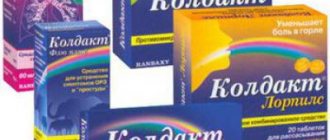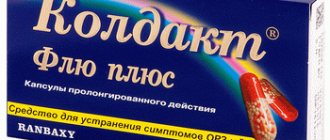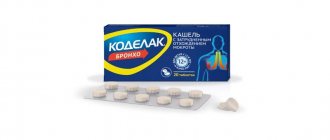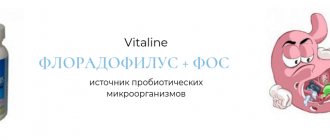Release form, packaging and composition of the drug Clinical-pharmacological group Pharmaco-therapeutic group Pharmacological action Indications for use Method of administration and doses Side effects Contraindications for use Use in children Special instructions Drug interactions
Registration Certificate Holder:
RANBAXY LABORATORIES, Ltd. (India)
ATX Code:
R05X
Active substance:
Dosage form:
Coldact Broncho
| The drug is approved for use as an over-the-counter product | Coldact Broncho | Syrup reg. No.: P N015189/01 dated 03.10.08 - Valid |
Composition and release form
| Syrup | 10 ml |
| ambroxol hydrochloride | 15 mg |
| chlorpheniramine maleate | 2 mg |
| guaifenesin | 100 mg |
| phenylephrine hydrochloride | 5 mg |
| excipients: methyl parahydroxybenzoate; propyl parahydroxybenzoate; sodium saccharin; sodium chloride; disodium edetate; sucrose; glycerol; xanthan gum; Sunset Yellow Supra dye (ci N15985); acesulfame potassium; grapefruit flavor 502010C; orange flavor 051941CS2; mint flavor 575010BT; citric acid monohydrate; sodium citrate; purified water |
in bottles of 60, 100, 150 and 200 ml (with a dosage spoon); 1 bottle in a cardboard pack.
Coldact Broncho
Active substance:
Pharmgroup:
Secretolytics and stimulants of motor function of the respiratory tract in combinations
Average price in pharmacies
| Name | Manufacturer | average price |
| Coldact with vitamin C n10 tablet p/capt/shells | RANBAXY | 191.00 |
| Coldact flu plus n10 caps prolong | RANBAXY | 190.00 |
Application area:Bacterial infections of the upper respiratory tract Bacterial respiratory infections Flu pain Viral respiratory disease Pain due to colds Viral respiratory tract infections Pain in infectious and inflammatory diseases of the upper respiratory tract Inflammatory disease of the upper respiratory tract Inflammatory diseases of the upper respiratory tract Inflammatory diseases of the upper respiratory tract with difficult to separate sputum Inflammatory diseases of the upper respiratory tract with difficult to separate sputum Inflammatory diseases of the respiratory tract Secondary infections with influenza Secondary infections due to colds Sticky sputum production Viscous sputum Hyperproduction of sputum Hypersecretion of bronchial glands Flu Flu in the initial stages of the disease Flu in children Influenza condition Influenza conditions Thick phlegm Blockage of the bronchi with mucus plug Difficulty in sputum discharge Difficulty releasing sputum Difficulty secreting sputum in acute and chronic respiratory diseases Difficulty secreting sputum in acute and chronic respiratory diseases Difficulty releasing sputum Upper respiratory tract infections Upper respiratory tract infections Respiratory tract infections Respiratory and lung infections ENT infections Infectious and inflammatory diseases of the upper respiratory tract Infectious and inflammatory diseases of the upper respiratory tract and ENT organs Infectious and inflammatory diseases of the upper respiratory tract in adults and children Infectious and inflammatory diseases of the upper respiratory tract Infectious inflammation of the respiratory tract Respiratory tract infection Influenza Qatar of the upper respiratory tract Catarrhal inflammation of the upper respiratory tract Catarrhal disease of the upper respiratory tract Catarrhal phenomena from the upper respiratory tract Cough in diseases of the upper respiratory tract Cough with a cold Cough with hard-to-clear sputum Cough with hard-to-clear sputum Fever due to influenza High viscosity sputum Beginning flu state ARVI acute respiratory infections Acute respiratory infection with symptoms of rhinitis Acute respiratory infection Acute infectious-inflammatory disease of the upper respiratory tract Acute parainfluenza disease Acute cold Acute respiratory disease Acute respiratory disease of influenza nature Parainfluenza Parainfluenza condition Sore throat or nose Poor sputum discharge Cold Colds Colds Respiratory infection Respiratory viral infections Respiratory diseases Respiratory infections Recurrent respiratory tract infections Seasonal colds Seasonal colds Difficult to clear viscous sputum Difficult sputum Difficult-to-discharge bronchial secretions Difficult to separate viscous secretion Frequent colds and viral diseases Influenza epidemics |
pharmachologic effect
Pharmacological action: anti-cold.
The effect of the drug is determined by the properties of its constituent components.
Guaifenesin and ambroxol
reduce the viscosity of bronchial secretions and facilitate expectoration.
Chlorpheniramine maleate
has an antiallergic effect - eliminates lacrimation, itching in the eyes and nose.
Phenylephrine hydrochloride
has a vasoconstrictor effect, reduces swelling and hyperemia of the mucous membranes of the upper respiratory tract and paranasal sinuses.
Contraindications
Hypersensitivity to any component of the drug, simultaneous use of other drugs containing substances included in Coldact® Broncho, simultaneous use of tricyclic antidepressants, MAO inhibitors, beta-blockers, seizures of any etiology, severe atherosclerosis of the coronary arteries, arterial hypertension, diabetes mellitus, thyrotoxicosis, pheochromocytoma, angle-closure glaucoma, peptic ulcer of the stomach and duodenum, prostate adenoma, deficiency of the enzyme glucose-6-phosphate dehydrogenase, pregnancy, lactation, children (up to 6 years).
With caution - renal and/or liver failure.
Side effects
Possible: increased blood pressure, tachycardia, headache, drowsiness, dizziness, dry mucous membranes, loss of appetite, difficulty urinating, allergic reactions (rash, itching, Quincke's edema), nausea, vomiting, constipation, diarrhea, pain in the epigastric region, increased excitability, difficulty falling asleep, mydriasis, paralysis of accommodation, increased intraocular pressure.
Children may experience agitation, restlessness and irritability.
In older patients, confusion or irritability may also occur.
Interaction
The drug enhances the effect of sedatives and ethanol.
Combined use with antidepressants, phenothiazine derivatives (chlorpromazine, trifluoperazine, levomepromazine), antiparkinsonian and antipsychotic drugs increases the risk of developing urinary retention, dry mouth, and constipation.
When used with GCS (prednisolone, dexamethasone, triamcinolone), the risk of developing glaucoma increases.
Chlorpheniramine, when used simultaneously with MAO inhibitors (nialamide), furazolidone, can lead to hypertensive crisis, agitation, and hyperpyrexia.
Combined use with tricyclic antidepressants enhances their sympathomimetic effect, with halothane - increases the risk of developing ventricular arrhythmia, with guanethidine - reduces its hypotensive effect, which, in turn, enhances the alpha-adrenergic stimulating activity of phenylephrine.
The simultaneous use of ambroxol and guaifenesin with antitussives leads to difficulty in sputum discharge.
Coldact Flu + extended-release capsules No. 10
A country
India
Country of manufacture may vary depending on the batch of goods. Please check with the operator for detailed information when confirming your order.
Active substance
Paracetamol + Chlorpheniramine + Phenylephrine
pharmachologic effect
Combined drug with prolonged action. Chlorphenamine has an antiallergic effect, eliminates lacrimation, itching in the eyes and nose. Paracetamol has an antipyretic and analgesic effect: reduces the pain syndrome observed during colds - sore throat, headache, muscle and joint pain, reduces high temperature. Phenylephrine has a vasoconstrictor effect - reduces swelling and hyperemia of the mucous membranes of the upper respiratory tract and paranasal sinuses .
Indications for use
- symptomatic treatment of colds, flu, acute respiratory viral infections (fever, pain, rhinorrhea).
Mode of application
Adults and children over 12 years old - 1 capsule every 12 hours for 3-5 days. Duration of use as an antipyretic - no more than 3 days; as a pain reliever - no more than 5 days. Coldact Flu Plus capsules are not recommended for use during pregnancy and lactation. Contraindicated in children under 12 years of age.
Interaction
The risk of developing hematotoxic effects of paracetamol increases with simultaneous use of barbiturates, diphenine, carbamazepine, rifampicin, zidovudine and other inducers of microsomal liver enzymes. Enhances the effects of sedative drugs, ethanol, MAO inhibitors. Antidepressants, phenothiazine derivatives, antiparkinsonian and antipsychotic drugs increase the risk of developing urinary retention, dry mouth, and constipation. GCS increase the risk of developing glaucoma. Paracetamol reduces the effectiveness of uricosuric drugs. Chlorphenamine combined with furazolidone can lead to hypertensive crisis, agitation, and hyperrexia. Tricyclic antidepressants enhance the adrenomimetic effect of phenylephrine; simultaneous administration of halothane increases the risk of developing ventricular arrhythmia. Reduces the hypotensive effect of guanethidine, which in turn enhances the alpha-adrenergic stimulating activity of phenylephrine.
Side effect
Increased blood pressure, tachycardia, drowsiness, difficulty falling asleep, dizziness, increased excitability, dry mucous membranes, mydriasis, accommodation paresis, increased intraocular pressure, loss of appetite, nausea, epigastric pain, anemia. Very rare: urinary retention, allergic reactions (skin rash, itching, urticaria, angioedema). Rarely: anemia, thrombocytopenia, leukemia, agranulocytosis. With long-term use in high doses, hepatotoxic and nephrotic effects are possible.
Contraindications
- hypersensitivity to any of the components included in the composition; - severe atherosclerosis of the coronary arteries; - arterial hypertension; - diabetes mellitus; - thyrotoxicosis; - angle-closure glaucoma; - severe diseases of the liver, kidneys, heart, bladder; - peptic ulcer of the stomach and duodenum intestines; - diseases of the pancreas; - difficulty urinating with prostate adenoma; - diseases of the blood system; - deficiency of glucose-6-phosphate dehydrogenase; - children under 12 years of age. With caution: congenital hyperbilirubinemia (Gilbert, Dubin-Johnson and Rotor syndromes) , bronchial asthma and chronic obstructive pulmonary disease.
Overdose
Symptoms caused by paracetamol appear after taking more than 10-15 g: pallor of the skin, decreased appetite, nausea, vomiting, hepatonecrosis, increased activity of liver transaminases, increased prothrombin time. Treatment: gastric lavage in the first 6 hours, administration of SH-group donors and precursors for the synthesis of glutathione-methionine 8-9 hours after an overdose and N-acetylcysteine after 12 hours. In case of accidental overdose, you should immediately consult a doctor, regardless of whether any symptoms of overdose are noted or not.
special instructions
Without a doctor's instructions, the drug should not be used by patients undergoing treatment with other medications, in particular MAO inhibitors. If, despite taking the drug, the disease is accompanied by ongoing fever or repeated increases in temperature are observed, you should consult a doctor. Do not take with alcohol or combine with other drugs containing paracetamol. When using Coldact Flu Plus, it is undesirable to use sleeping pills, tranquilizers and other psychotropic drugs. It distorts laboratory test results in the quantitative determination of glucose and uric acid in plasma. In case of long-term treatment, peripheral blood parameters and the functional state of the liver are monitored. Impact on the ability to drive vehicles and operate machinery During the treatment period, it is necessary to refrain from driving vehicles and engaging in potentially hazardous activities that require increased concentration and speed of psychomotor reactions.
Synonyms of nosological groups
| Category ICD-10 | Synonyms of diseases according to ICD-10 |
| J06 Acute upper respiratory tract infections of multiple and unspecified localization | Bacterial infections of the upper respiratory tract |
| Bacterial respiratory infections | |
| Pain due to colds | |
| Pain in infectious and inflammatory diseases of the upper respiratory tract | |
| Viral respiratory disease | |
| Viral respiratory tract infections | |
| Inflammatory disease of the upper respiratory tract | |
| Inflammatory diseases of the upper respiratory tract | |
| Inflammatory diseases of the upper respiratory tract with difficult to separate sputum | |
| Inflammatory diseases of the respiratory tract | |
| Secondary infections with influenza | |
| Secondary infections due to colds | |
| Influenza conditions | |
| Difficulty secreting sputum in acute and chronic respiratory diseases | |
| Upper respiratory tract infections | |
| Upper respiratory tract infections | |
| Respiratory tract infections | |
| Respiratory and lung infections | |
| ENT infections | |
| Infectious and inflammatory diseases of the upper respiratory tract | |
| Infectious and inflammatory diseases of the upper respiratory tract and ENT organs | |
| Infectious and inflammatory diseases of the upper respiratory tract in adults and children | |
| Infectious and inflammatory diseases of the upper respiratory tract | |
| Infectious inflammation of the respiratory tract | |
| Respiratory tract infection | |
| Qatar of the upper respiratory tract | |
| Catarrhal inflammation of the upper respiratory tract | |
| Catarrhal disease of the upper respiratory tract | |
| Catarrhal phenomena from the upper respiratory tract | |
| Cough in diseases of the upper respiratory tract | |
| Cough with a cold | |
| Fever due to influenza | |
| ARVI | |
| acute respiratory infections | |
| Acute respiratory infection with symptoms of rhinitis | |
| Acute respiratory infection | |
| Acute infectious-inflammatory disease of the upper respiratory tract | |
| Acute cold | |
| Acute respiratory disease | |
| Acute respiratory disease of influenza nature | |
| Sore throat or nose | |
| Cold | |
| Colds | |
| Colds | |
| Respiratory infection | |
| Respiratory viral infections | |
| Respiratory diseases | |
| Respiratory infections | |
| Recurrent respiratory tract infections | |
| Seasonal colds | |
| Seasonal colds | |
| Frequent colds and viral diseases | |
| J11 Influenza, virus not identified | Flu pain |
| Flu | |
| Flu in the initial stages of the disease | |
| Flu in children | |
| Influenza condition | |
| Influenza | |
| Beginning flu state | |
| Acute parainfluenza disease | |
| Parainfluenza | |
| Parainfluenza condition | |
| Influenza epidemics | |
| R05 Cough | Severe cough |
| Cough | |
| Cough in the preoperative period | |
| Cough due to allergic conditions | |
| Cough with bronchial asthma | |
| Cough with bronchitis | |
| Cough due to inflammatory diseases of the lungs and bronchi | |
| Cough in diseases of the upper respiratory tract | |
| Cough with a cold | |
| Cough due to tuberculosis | |
| Cough with hard-to-clear sputum | |
| Cough with hard-to-clear sputum | |
| Dry cough | |
| Nonproductive cough | |
| Paroxysmal cough | |
| Paroxysmal nonproductive cough | |
| Productive cough | |
| Reflex cough | |
| Coughing | |
| Spasmodic cough | |
| Spasmodic cough | |
| Dry cough | |
| Dry painful cough | |
| Dry non-productive cough | |
| Dry irritating cough | |
| R09.3 Sputum | Bronchial asthma with difficulty in sputum discharge |
| Inflammatory diseases of the upper respiratory tract with difficult to separate sputum | |
| Sticky sputum production | |
| Viscous sputum | |
| Hyperproduction of sputum | |
| Hypersecretion of bronchial glands | |
| Thick phlegm | |
| Blockage of the bronchi with mucus plug | |
| Difficulty in sputum discharge | |
| Difficulty releasing sputum | |
| Difficulty secreting sputum in acute and chronic respiratory diseases | |
| Difficulty releasing sputum | |
| Cough with hard-to-clear sputum | |
| Cough with hard-to-clear sputum | |
| High viscosity sputum | |
| Poor sputum discharge | |
| Difficult to clear viscous sputum | |
| Difficult sputum | |
| Difficult-to-discharge bronchial secretions | |
| Difficult to separate viscous secretion |
Use of the drug Koldakt
Coldact Broncho: children aged 2 to 5 years are prescribed 5 ml (1 teaspoon), 6-12 years - 10 ml (2 teaspoons) 3-4 times a day. Adults and children over 12 years of age are prescribed 20 ml (4 teaspoons) 3-4 times a day. Coldact Flu Plus: adults and children aged 12 years and older for colds are prescribed 1 capsule every 12 hours for 1-3 days, for the treatment of chronic rhinitis - 1 capsule every 12 hours for 3-6 days, in In some cases, therapy can be extended up to 30 days; for the treatment of sinusitis - 1 capsule every 12 hours for 6-12 days. The capsule must be taken without chewing with a glass of water.








